
The United States Postal Service (USPS), also known as the Post Office, U.S. Mail, or simply the Postal Service, is an independent agency of the executive branch of the United States federal government responsible for providing postal service in the United States, its insular areas and associated states. It is one of a few government agencies explicitly authorized by the Constitution of the United States. As of 2023, the USPS has 525,469 career employees and 114,623 non-career employees.

A ZIP Code is a system of postal codes used by the United States Postal Service (USPS). The term ZIP was chosen to suggest that the mail travels more efficiently and quickly when senders use the code in the postal address. The Philippine Postal Corporation also uses this terminology for the postal code system in the Philippines.
Canada Post Corporation, trading as Canada Post, is a Canadian Crown corporation that functions as the primary postal operator in Canada.
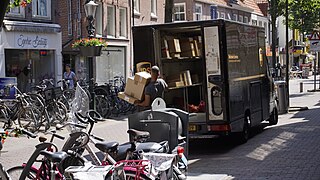
Package delivery, or parcel delivery, is the delivery of shipping containers, parcels, or high-value mail as single shipments. The service is provided by most postal systems, express mail, private courier companies, and less-than-truckload shipping carriers. Package delivery differs by country due to cost and population. In 2019, for example, China, the United States, and Japan were the top countries in terms of package delivery volume while Latvia, Macau, and Iceland ranked at the bottom. This can be explained in part by the population of the bottom three nations totaling 2 million while the top three represent a population of almost 2 billion.

A mail carrier, also referred to as a mailman, mailwoman, mailperson, postal carrier, postman, postwoman, postperson, person of post, letter carrier, or colloquially postie, is an employee of a post office or postal service who delivers mail and parcel post to residences and businesses. The term "mail carrier" came to be used as a gender-neutral substitute for "mailman" soon after women began performing the job. In the Royal Mail, the official name changed from "letter carrier" to "postman" in 1883, and "postwoman" has also been used for many years.
In a postal system, a delivery point is a single mailbox or other place at which mail is delivered. It differs from a street address, in that each address may have several delivery points, such as an apartment, office department, or other room. Such buildings are often called multiple-dwelling units (MDUs) by the USPS.
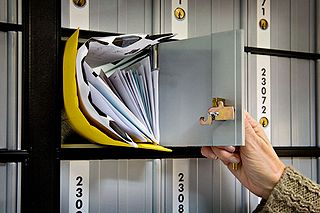
A post office box is a uniquely addressable lockable box located on the premises of a post office.

A letter box, letterbox, letter plate, letter hole, mail slot or mailbox is a receptacle for receiving incoming mail at a private residence or business. For outgoing mail, post boxes are often used for depositing the mail for collection, although some letter boxes are also capable of holding outgoing mail for a carrier to pick up. Letterboxes or mailboxes use the following primary designs:
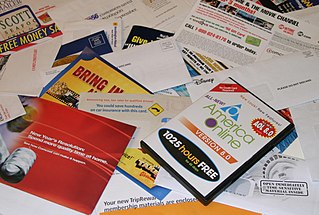
Advertising mail, also known as direct mail, junk mail, mailshot or admail, letterbox drop or letterboxing (Australia), is the delivery of advertising material to recipients of postal mail. The delivery of advertising mail forms a large and growing service for many postal services, and direct-mail marketing forms a significant portion of the direct marketing industry. Some organizations attempt to help people opt out of receiving advertising mail, in many cases motivated by a concern over its negative environmental impact.
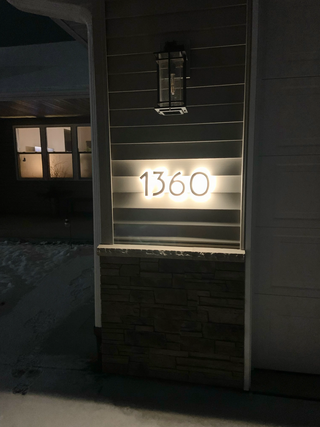
An address is a collection of information, presented in a mostly fixed format, used to give the location of a building, apartment, or other structure or a plot of land, generally using political boundaries and street names as references, along with other identifiers such as house or apartment numbers and organization name. Some addresses also contain special codes, such as a postal code, to make identification easier and aid in the routing of mail.
A suite is the location of a business within a shopping mall or office building. The suite's number also serves as a sort of address within an address for purposes of mail delivery and pickup.

A post box, also known as a collection box, mailbox, letter box or drop box, is a physical box into which members of the public can deposit outgoing mail intended for collection by the agents of a country's postal service. The term post box can also refer to a private letter box for incoming mail.

Rural Free Delivery (RFD), since 1906 officially rural delivery, is a program of the United States Post Office Department to deliver mail directly to rural destinations. The program began in the late 19th century. Before that, people living in rural areas had to pick up mail themselves at sometimes distant post offices or pay private carriers for delivery.

Freepost is a postal service provided by various postal administrations, whereby a person sends mail without affixing postage, and the recipient pays the postage when collecting the mail. Freepost differs from self-addressed stamped envelopes, courtesy reply mail, and metered reply mail in that the recipient of the freepost pays only for those items that are actually received, rather than for all that are distributed. Freepost of preprinted cards issued by businesses is also different from postal stationery sold by postal administrations.
Post offices and other mail service providers typically offer a mail forwarding service, commonly known as hybrid mail or virtual post office box services, to redirect mail addressed to one location to another address – usually for a given period. In the case of the United States Postal Service's First Class Mail, it is generally for a period of one year. British Royal Mail provides a service called Mail Redirection, enabling redirection for up to two years. Customers of such a service usually, but not exclusively, use mail forwarding when they change an address.
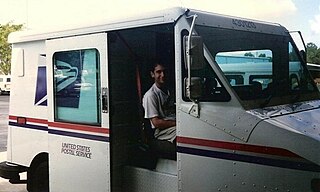
Rural letter carriers are United States Postal Service and Canada Post employees who deliver mail in what are traditionally considered rural and suburban areas of the United States and Canada. Before Rural Free Delivery (RFD), rural Americans and Canadians were required to go to a post office to get their mail.
Centralized mail delivery is a unique form of mail delivery system where a letter carrier provides delivery and collection services to a number of residences from a centrally located installation – whether in a single-family subdivision or multi-family structure. Business customers also receive delivery services from a convenient central location. Centralized mail delivery equipment can be in the form of any "clustered" type mailbox – including free-standing, pedestal-mounted cluster box unit (CBU), or other cluster mailboxes mounted in a wall, kiosk, or shelter. The U.S. Postal Service prefers centralized mail delivery in all new construction because it is less expensive. The United States Postal Service aims to continue to review and modify its operations to provide universal service as efficiently and cost effectively as possible. Therefore, there is pressure to establish centralized mail delivery, which is required in some communities.
STD-4C or STANDARD-4C refers to a set of standards and regulations set by the United States Postal Service regarding the specifications of cluster mailbox units used in new construction. All multi unit constructions building plans submitted after October 6, 2006 are required to use STD-4C compliant mailboxes
A Nixie is a name given by the United States Postal Service to a piece of mail which is undeliverable as addressed. It is derived from "nix", English slang for the German nichts ("nothing"), and "-ie", an item or a thing.
A virtual mailbox is a service that receives physical mail on behalf of the addressee and usually scans the outside of the mail. Some providers also scan the inside contents of the mail as well. These scans may be photos, PDFs, or text-searchable PDFs. Reasons for using virtual mailboxes may include accepting mail from couriers, accessing mail while traveling, and keeping a home address private.











